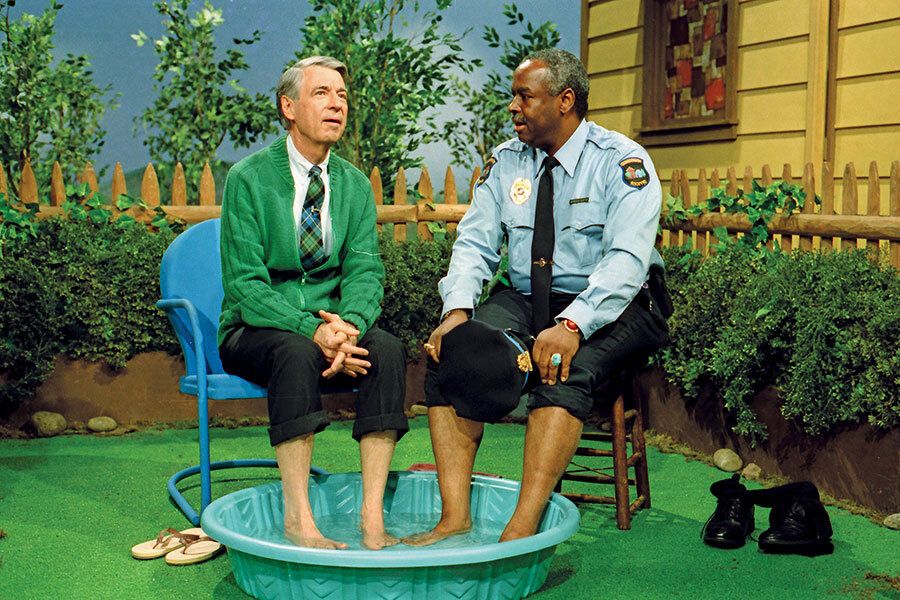'Mister Rogers' documentary 'Won’t You Be My Neighbor?' is full of sentiment, affection
Loading...
I’m tempted to say that the documentary “Won’t You Be My Neighbor?” is exactly what we need in these scabrous times, but that makes it sound too self-important. And if there is one thing that Fred Rogers, the host and creator of the beloved educational children’s show “Mister Rogers’ Neighborhood,” would disdain, it’s self-importance. That, and being disrespectful of children.
Morgan Neville’s movie is more than just a chronicle of Rogers’s career. In some not-quite-definable way, the film itself is all of a piece with Rogers’s principled gentleness. It’s a love letter, but the sentiment and affection that pour through the film is honestly arrived at, even when, near the end, the film threatens to turn into the cinematic equivalent of a group hug.
Neville and his collaborators have done a thorough dig through Rogers’s life and work, drawn from a lifetime of archives right through his death in 2003, but there are no besmirching revelations to be found here. The worst charge leveled against Rogers, a lifelong registered Republican, comes from a few right-wing talking heads who accuse him of coddling an entire generation of Millennials into a false sense of entitlement. Would the world be a better place if, instead, we had had “Mister Rogers’ Tough-Love Neighborhood”?
The simple fact is that Rogers, who is now on a postage stamp and will be portrayed in an upcoming biopic by Tom Hanks, is exactly as advertised: a genuinely caring man who can unabashedly say, “Love is at the root of everything.... Love or the lack of it.” One can certainly, with a head full of cynicism, argue this point, but one can’t argue with Rogers’s sincerity. Or his achievement. (The show, which started in the United States nationwide in 1968 on NET, ran for more than 30 years.)
Prior to his TV career, Rogers studied in a seminary and eventually became an ordained Presbyterian minister, and so it’s not surprising when one of his colleagues says in the movie, “There was a noble, spiritual dimension to what he did.” But, at least in terms of the TV show, it was a strictly nondenominational spirituality. He had an ecumenical embrace, and children responded to him because he didn’t judge them. He wanted them to know every one of them had value.
Rogers first got the idea for the show after seeing all the balloons and Bozos on children’s television and thinking there must be a better and more meaningful way of reaching out to little kids. Again, one can argue this point: You can love “Mister Rogers’ Neighborhood,” with its pipsqueak puppets, miniature trolleys, and genial human cast of characters and still, at the same time, love “Looney Tunes” cartoons and “Tom and Jerry.”
But Rogers, with a tiny budget and minimal props, created a world that children entered into for a half-hour each week with the full expectation they would be reuniting with a friend. There’s a clip in the documentary of a girl, perhaps 5 or 6, who shyly walks up to Rogers during what looks like an informal get-together on the set and says, “I want to tell you something.... I like you.”
Anybody who can keep a dry eye at a moment like that is made of sterner stuff than I. Or, for that matter, Sen. John Pastore, the initially brusque congressional subcommittee chairman who, as we see in a clip from a 1969 hearing to determine the endangered budget for the Corporation for Public Broadcasting and the Public Broadcasting Service, melted in simple gratitude after hearing Rogers’s pleaful testimony. (The documentary, by necessity, only shows a portion of Rogers’s speech, but it’s worth checking out the whole segment on YouTube, where it enjoyed a resurgence following President Trump’s proposed plan to pull all federal funding for the CPB.)
Eddie Murphy’s satirical jab at the show on “Saturday Night Live” was wickedly funny but also misguided. Rogers, with his cardigans, soft shoes, and soft voice, did not reside in cloud cuckooland. He dealt with divorce and dying on the show, in ways that children could comprehend. In 1986, he devoted a week to the trauma of the Challenger explosion. When it was widely reported that a white man had dumped bleach into a public pool to drive out black children, he featured a segment in which Mr. Rogers and Officer Clemmons, played by the black actor François Clemmons, share a foot bath.
I was just starting high school when “Mister Rogers’ Neighborhood” first aired, and, in my adolescent arrogance, I pretended it was all silly stuff. But the truth is, the basic decency of the show spoke to me then and, as this movie reminds me, it still does. Grade: A- (Rated PG-13 for some thematic elements and language.)





